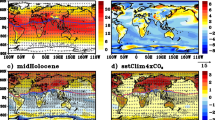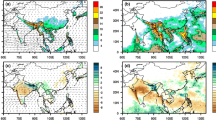Abstract
Intense rains on 16–17 June 2013 over Mandakini River catchment caused Kedarnath disaster in Uttarakhand State (India). Normal and departure-from-normal 3D global atmospheric thermal structure and general and monsoon circulations during the event have been compared using equatorially/globally- conditioned surface and upper air parameters (1000–100 hPa) (period: 1979–2013). Briefly, normal monsoon structure is: 1000‒850 hPa layer- cross-equatorial flows over Indian Ocean and Eurasian westerlies confluence over Indian domain, the two flows further confluence downstream with Pacific easterlies and then the accumulated airmasses blow northeastward; 700‒500 hPa layer- Eurasian westerlies after sweeping entire Indian subcontinent make exit northeastward; and 400‒100 hPa layer- upper tropospheric anticyclone well-developed over subtropical Asia and outflows are spread all around. On 16–17 June 2013, two upper tropospheric anticyclonic cells occurred, one over Tibet-China and another Mediterranean-Middle East. Troposphere (1000–250 hPa) was significantly warmer-and-thicker over Tibet-China followed by Mediterranean-Middle East while cooler-and-thinner over central Asia-India sector. Departures in downward slopes of tropospheric temperature and thickness from Tibet-China outward were significantly steeper. A huge trough evolved over Indo-Pacific region from an interaction between Eurasian westerlies and Indo-Pacific easterlies, and outflows from the trough made forced exit through western Himalaya which modulated north mid-high latitudes westerlies into a single wave structure. Combined five factors produced disastrous rains over Kedarnath: cool-low and warm-low regime contrast; squeezing of deep warm-moist flows; orographic lifting; and pumping and suction effects. Forced warm-moist outflows from Indo-Pacific region caused warmer-thicker troposphere over eastern Russia-North America. Lesser outflows from Tibet-China anticyclone were directed southward, consequently troposphere was cooler-thinner over southern mid-high latitudes.












Similar content being viewed by others
Abbreviations
- AIP:
-
Asia-Indo-Pacific
- CA-IND:
-
Central Asia – India
- CH:
-
Cool-high
- CL:
-
Cool-low
- EC-mslp:
-
Equatorially Conditioned mean sea level pressure
- EC-PW:
-
Equatorially Conditioned Precipitable Water
- EC-Tlevel :
-
Equatorially Conditioned Temperature at particular level
- EC-TTROP :
-
Equatorially Conditioned Tropospheric temperature
- EC-Zlevel :
-
Equatorially Conditioned geopotential height at particular level
- EC-ZTROP :
-
Equatorially Conditioned Tropospheric Thickness
- EMV:
-
Equatorial Mean Value
- EREs:
-
Extreme Rain Events
- GC-W:
-
Globally Conditioned Wind Speed
- GMV:
-
Global Mean Value
- GWRs:
-
Global Weather Regimes
- LOSSI:
-
Location, orientation, shape, size and intensity
- MME:
-
Mediterranean – Middle East
- NH:
-
Northern Hemisphere
- NPL:
-
North Polar
- NSBT:
-
North Subtropic
- SH:
-
Southern Hemisphere
- SPL:
-
South Polar
- SSBT:
-
South Subtropic
- TBT-CHN:
-
Tibet-China
- WL:
-
Warm-low
- WH:
-
Warm-high
References
Ashrit R (2010) A report on investigating the Leh cloudburst. NCMRWF report No. NMRF/RR/2010, 18pp
Bohlinger P, Sorteberg A, Sodemann H (2017) Synoptic conditions and moisture sources actuating extreme precipitation in Nepal. J Geophys Res 122(12):653–671
Bohlinger P, Sorteberg A, Liu C, Rasmussen R, Sodemann H, Ogawa F (2019) Multiscale characteristics of an extreme precipitation event over Nepal. Q J R M S 145:179–196. https://doi.org/10.1002/qj.3418
Chaudhari C, Tripathi S, Srivastava R, Misra A (2015) Observation- and numerical -analysis-based dynamics of the Uttarkashi cloudburst. Ann Geophys 33:671–686
Chevuturi A, Dimari AP (2016) Investigation of Uttarakhand (India) disaster-2013 using weather research and forecasting model. Nat Hazards 82(3):1703–1726
Chevuturi A, Dimari AP, Das S, Kumar A, Niyogi D (2015) Numerical simulation of an intense precipitation event over Rudraprayag in the central Himalyas during 13–14 September 2012. J Earth Syst Sci 124(7):1545–1561
Cho C, Li R, Wang S, Yoon JH, Gillies, RR (2015) Anthropogenic footprint of climate change in the June 2013 northern India flood. Plants, Soils, and Climate Faculty Publications. Paper 735, 26pp
Dobhal DP, Gupta AK, Mehta M, Khandelwal DD (2013) Kedarnath disaster: facts and plausible causes. Curr Sci 105(2):171–174
Dube A, Ashrit R, Ashish A, Sharma K, Iyengar GR, Rajagopal EN, Basu S (2014) Forecasting the heavy rainfall during Himalayan flooding-June 2013. Weather Clim Extremes 4:22–34
Dubey CS, Shukla DP, Ningreichon AS, Usham AL (2013) Orographic control of the Kedarnath disaster. Curr Sci 105(11):1474–1476
Hong CC, Hsu HH, Lin NH, Chiu H (2011) Roles of European blocking and tropical-extratropical interaction in the 2010 Pakistan flooding. Geophy Res Lett 38:L13806. https://doi.org/10.1029/2011GL047583
Houze RA, Rasmussen KL, Medina S, Brodzik SR, Romatschke U (2011) Anomalous atmospheric events leading to the summer 2010 floods in Pakistan. Bull Am Meteor Soc 92:291–298
Houze RA, McMurdie LA, Rasmuseen KL, Kumar A, Chaplin MM (2017) Multiscale aspects of the storm producing the June 2013 flooding in Uttarakhand, India. Mon Wea Rev 145(11):4447–4466. https://doi.org/10.1175/MWR-D-17-0004.1
Joseph S, Sahai AK, Sharmila S, Abhilash S, Borah N, Chattopadhyay R, Pillai PA, Rajeevan M, Kumar A (2015) North Indian heavy rainfall event during June 2013: diagnostics and extended range prediction. Clim Dyn 44:2049–2065
Kotal SD, Roy SS, Bhowmik SKR (2014) Catastrophic heavy rainfall episode over Uttarakhand during 16–18 June 2013—observational aspects. Curr Sci 107(2):234–245
Krishnamurti TN, Kumar V, Simon A, Thomas A, Bhardwaj A, Das S, Sen Roy S, Roy Bhowmik RK (2017) March of buoyancy elements during extreme rainfall over India. Clim Dyn 48:1931–1951
Kumar A, Houze RA, Rasmussen KL (2014) Simulation of a flash flooding storm at the steep edge of the Himalyas. J Hydrometeorol 15:212–228
Lau W, Kim KM (2012) The 2010 Pakistan and Russian heat wave: teleconnection of hydro -meteorological extremes. J Hydrometerol 13:392–403
Martha TR, Roy P, Govindraj KB, Kumar V, Diwakar PG, Dhadwal VK (2015) Landslides triggered by the June 2013 extreme rainfall event in parts of Uttarakhand state, India. Landslides 12:135–146
Mishra A, Srinivasan J (2013) Did a cloud burst occur in Kedarnath during 16 and 17 June 2013? Curr Sci 105(10):1351–1352
NATMO (1986) National Atlas of India Physiographic Regions of India. Third edition, Plate 41, Prepared under the Direction of G.K. Dutt, Director, NATMO (the National Atlas & Thematic Mapping Organization), Kolkata, India
Parida BR, Behera SN, Bakimchandra O, Pandey AC, Singh N (2017) Evaluation of satellite-derived rainfall estimates for an extreme rainfall event over Uttarakhand, Western Himalayas. Hydrology 22(4):1–18. https://doi.org/10.3390/hydrology4020022
Priya P, Krishnan R, Mujumdar M, Houze RA Jr (2017) Changing monsoon and midlatitude circulation interactions over the Western Himalayas and possible links to occurrences of extreme precipitation. Clim Dyn 49:2351–2364
Rajeevan M, Bhate J (2008) A high resolution daily gridded rainfall Data Set (1971–2005) for Mesoscale Meteorological Studies. National Climate Center, India meteorological Department, Research Report No.9, 14pp
Ranade A, Singh N (2019) Equatorially/Globally conditioned meteorological analysis of heaviest rains over India during 23–28 July 2005. Meteorol Atmos Phys 131(4):919–944. https://doi.org/10.1007/s00703-018-0613-6
Ranalkar MR, Chaudlhari HS, Hazra A, Sawaisarje GK, Pokhrel S (2016) Dynamical features of incessant heavy rainfall event of June 2013 over Uttarakhand, India. Nat Hazards 80:1579–1601
Rasmussen KL, Houze RA (2012) A flash-flooding storm at the steep edge of high terrain: disaster in the Himalayas. Bull Am Met Soc 93:1713–1724
Rasmussen KL, Hill AJ, Toma VE, Zuluaga MD, Webster PJ, Houze RA (2015) Multiscale analysis of three consecutive years of anomalous flooding in Pakistan. Quart J R Met Soc 141:1259–1276
Ray C, Chattoraj PK, Bisht SL, MPS et al (2016) Kedarnath disaster 2013: causes and consequences using remote sensing inputs. Nat Hazards 81:227–243
Saha S et al (2010) The NCEP climate forecast system reanalysis. Bull Am Meteorol Soc 91(8):1015–1057. https://doi.org/10.1175/2010BAMS3001.1
Saha S et al (2014) The NCEP climate forecast system version 2. J Clim 27:2185–2208. https://doi.org/10.1175/JCLI-D-12-00823.1
Sati VP (2013) Extreme weather-related disasters: a case study of two flash floods hit areas of Badrinath and Kedarnath valleys, Uttarakhand Himalaya, India. J Earth Sci Engg 3:562–568
Shekhar MS, Pattanayak S, Mohanty UC, Paul S, Sravana Kumar SM (2015) A study on the heavy rainfall event around Kedarnath area (Uttarakhand) on 16 June 2013. J Earth Syst Sci 124(7):1531–1544
Singh D, Horton DE, Tsiang T, Haugen M, Ashfaq M, Mei R, Rastogi D, Johnson NC, Charland A, Rajaratnam B, Diffenbaugh NS (2014) Severe precipitation in Northern India in June 2013: causes, historical context, and changes in probability. Bull Am Meteorol Soc 95(9):558–561
Srinivasan J (2013) Predicting and managing extreme rainfall. Curr Sci 105:7–8
Thayyen R, Dimri AP, Kumar P, Agnihotri G (2013) Study of cloudburst and flash floods around Leh, India during August 4–6, 2010. Natur Hazards 65(3):2175–2204
Vellore RK, Kaplan ML, Krishnan R, Lewis JM, Sabade S, Deshpande N, Singh BB, Madhura RK, Rama Rao MVS (2016) Monsoon-extratropical circulation interactions in Himalayan extreme rainfall. Clim Dyn 46:3517–3546
Vellore RK, Bisht JS, Krishnan R, Uppara U, Capua GD, Coumou D (2019) Sub-synoptic circulation variability in the Himalayan extreme precipitation event during June 2013. Meteorol Atmos Phys. https://doi.org/10.1007/s00703-019-00713-5
Webster PJ, Toma VE, Kim HM (2011) Were the 2010 Pakistan floods predictable? Geophys Res Lett 38:L04806
Acknowledgements
First author is extremely gratefully to Director, National Institute of Hydrology, Roorkee for necessary facilities to pursue the study, and to the Department of Science and Technology (DST), Govt. of India for sponsoring this research project.
Author information
Authors and Affiliations
Corresponding author
Additional information
Responsible Editor: Silvia Trini Castelli.
Publisher's Note
Springer Nature remains neutral with regard to jurisdictional claims in published maps and institutional affiliations.
Rights and permissions
About this article
Cite this article
Ashwini, R., Nityanand, S. Evaluation of 3D structural changes in general atmospheric and monsoon circulations during Kedarnath disaster (India), 16–17 June 2013. Meteorol Atmos Phys 133, 857–878 (2021). https://doi.org/10.1007/s00703-021-00780-7
Received:
Accepted:
Published:
Issue Date:
DOI: https://doi.org/10.1007/s00703-021-00780-7




